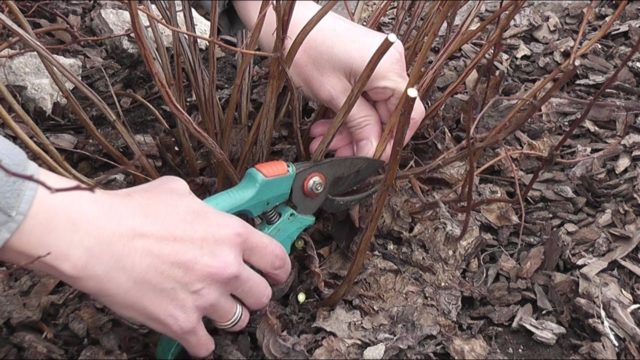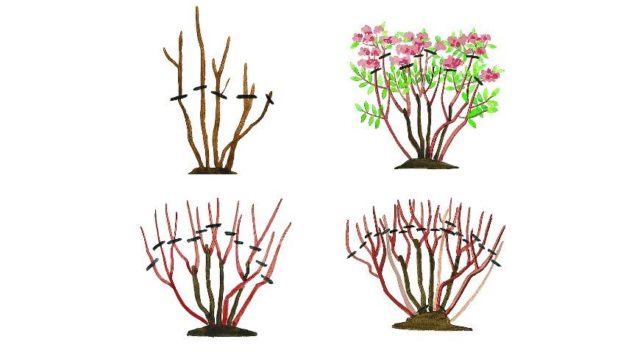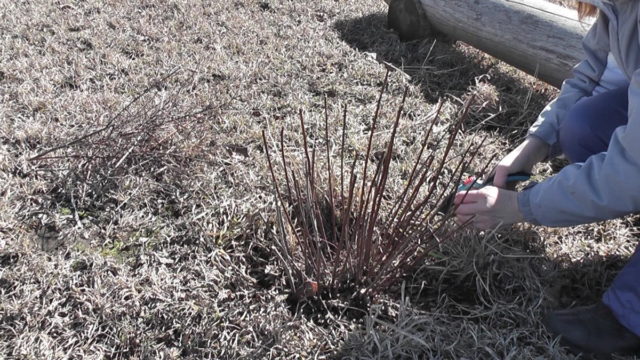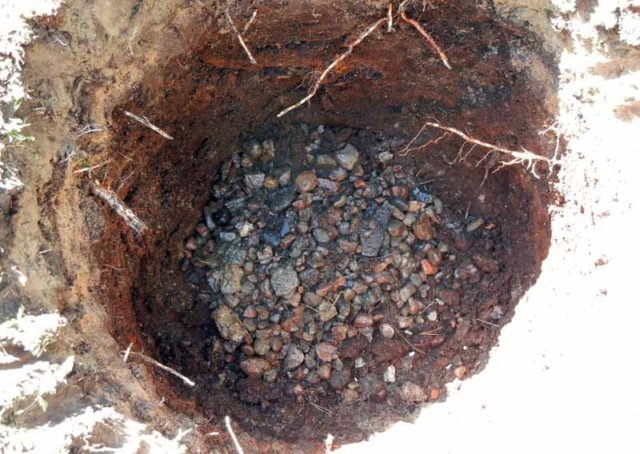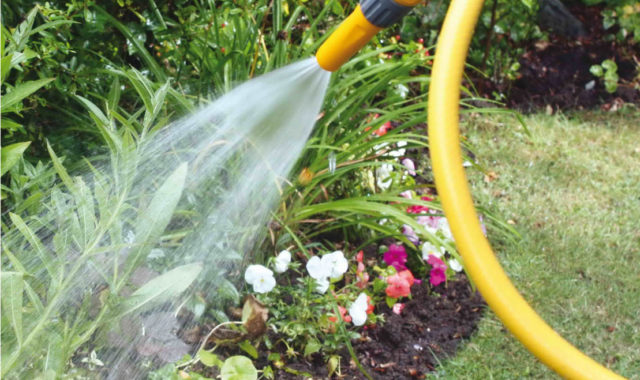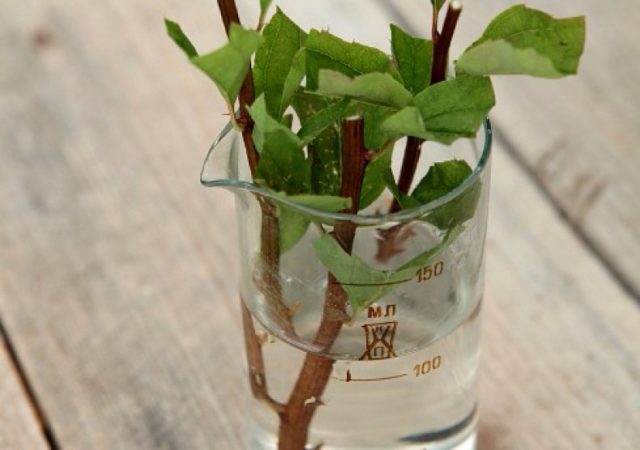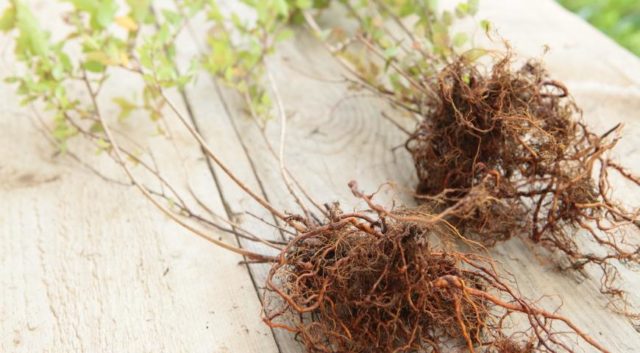Content
- 1 Autumn pruning of spirea
- 2 How to properly plant spirea in the fall
- 3 How to care for spirea in the fall
- 4 How to prepare spirea for winter
- 5 How to propagate spirea in the fall
- 6 Conclusion
Spirea is well known to many flower growers, landscape designers and ordinary lovers of decorative flowers. Caring for it is simple, and most of the growing operations, which include pruning spirea in the fall, can be performed even by a novice gardener. This will take a very small amount of time and the simplest tools.
Autumn pruning of spirea
Pruning is a necessary part of the complex of measures for the care of this shrub. It helps to maintain abundant flowering, and also constantly rejuvenates the bush. The pruning method depends on the age of the bush, the type of plant, and the time of its flowering.
Some growers consider this operation unnecessary. However, without it, the bush will quickly turn into shaggy and sloppy, the shoots will stretch and thin out, and the flowers are crushed. Old dried branches will accumulate inside the bush, which will impede air exchange, which will ultimately lead to stagnation of air inside the bush and an increase in humidity. All these factors can cause fungal diseases.
When to trim spirea - in spring or autumn
Throughout the season, you need to sanitize the bush, removing broken and dried shoots. Full pruning is best done in the fall. The only exceptions are the northernmost areas where this shrub is grown. In them, due to the peculiarities of the climate, after the autumn haircut, the spirea may simply not have time to recover before the arrival of cold weather. Therefore, in such areas, it is cut in the spring.
Do I need to trim the spirea for the winter
No additional pruning is required as a winterization measure. Most species of this plant are winter-hardy and easily tolerate even the most severe frosts. Before winter, it is enough to tie all the shoots into one bunch, bend them to the ground, and then cover them with a layer of mulch and snow. Varieties that do not differ in sufficient frost resistance are bent to the ground, fixed, and why they are covered with a thick layer of fallen leaves, straw or sawdust.
Types and timing of pruning spirea in the fall
For the first few years after planting, the bush is not pruned, as this can worsen the condition of its root system. Starting from 3-4 years of age, the following types of pruning can be carried out:
- Stimulating. This pruning consists in pruning all lignified shoots at a height of about 30 cm. This measure stimulates the growth of new lateral shoots. The procedure is carried out in mid-autumn, before the temperature begins to drop below 0 ° C.
- Anti-aging. This is a type of deep pruning that allows the actual growth of a new shrub. Rejuvenating pruning is carried out in September-October, completely cutting off all shoots at soil level.This procedure is recommended for old bushes or bushes damaged by pests. In the spring, the spirea will grow again, giving powerful shoots from the buds located near the root collar.
How to prune a spirea in the fall
In autumn, the shoots are cut to the level at which the buds of the lignified part are located. At the same time, the formation of the bush is carried out. It is also necessary to remove some shoots from the interior to maintain proper air exchange and prevent mold growth.
Pruning spirea in summer blooming autumn
You can start pruning varieties of the summer flowering period starting from 4 years of life of the bush. In summer, shoots can be shortened by one third to stimulate lateral shoot formation and enhance flowering. At the beginning of autumn, sanitary cleaning should be carried out, branches that are growing incorrectly and lagging behind in development should be removed. Once every 7-8 years, it is necessary to intensively thin out the bush, leaving several of the most powerful shoots, and completely remove all the rest.
Pruning early flowering spirea in autumn
Early varieties bloom on last year's shoots. In the fall, it is required to remove about one fifth of each bush by pruning them at ground level. This stimulates increased spring growth.
Spirea pruning scheme in autumn
The spirea bush takes several years to form. In the second year of life, you can start pruning it. It is produced according to the following scheme:
- Sick, damaged and dry shoots are completely cut out. If the branch is broken, then it is cut to 1 living bud.
- In young shoots, the tips that did not have time to woody are cut off.
- For shrubs over 5 years old, you can begin to carry out anti-aging pruning, removing several adult shoots in order to replace them with young ones.
If, after rejuvenating pruning, there is no enhanced formation of new strong shoots, you should think about planting a new plant.
Pruning spirea in the fall for beginners:
How to properly plant spirea in the fall
This ornamental shrub looks great both individually and in group planting. For example, it is often used as a hedge. Before planting, you need to choose a suitable place, and also stock up on a sufficient amount of planting material.
Landing site preparation
A planted spirea will do well in an open, well-lit area with loose soil. It should be borne in mind that partial shade has a good effect on this plant, it feels better in such conditions and gives brighter flowers, but their number will be less than when grown in open areas.
Sand or peat is often added to loosen the soil. These plants do not tolerate excess moisture, therefore swampy areas of the terrain are not suitable for planting them. Conifers get along best as neighbors with spirea.
Preparation of planting material
As a rule, the seedlings of this shrub are sold in nurseries or specialty stores. Their root system must be closed, that is, the seedling must have a clod of earth on the roots. It is preferable that it is young and does not have leaves, since their presence negatively affects the survival rate of the plant. If the root system of the seedling is open, it must be examined. The roots should be moist, pliable, and free from blackness. It is encouraged if they are covered with a mixture of manure and clay. The bark of the seedlings must be green, and the buds must be alive and healthy.
Rules for planting spirea in the fall in open ground
In the fall, it is allowed to plant a spirea of both spring and summer flowering periods. It is better to do this in wet rainy weather, so the plants take root better. The planting hole needs to be prepared a few days before planting.Its size should exceed the volume of the root system together with a lump of earth. The pit walls are made vertical. A drainage layer of broken brick, expanded clay or crushed stone must be laid on the bottom.
Then an earthen mound is poured in the center of the pit. A seedling is installed on it. If the root system is open, the roots of the seedling are spread along the walls of the earthen mound, and then sprinkled with soil up to half. After that, a bucket of water is added to the pit and finally fall asleep. The soil is slightly compacted, an earthen bead is poured around the seedling to prevent water from spreading during irrigation. After that, the root zone is mulched with peat or humus.
How to transplant spirea to a new place
Spirea that has not reached 4 years of age can be safely transplanted to another place in the fall. The easiest way to do this is by digging it up along with a clod of earth on the roots, and then planting it in another place. The root system of older bushes is already quite well developed, so transplanting an adult spirea in the fall will be fraught with certain difficulties. In this case, often not the entire bush is transplanted, but only part of it.
How to care for spirea in the fall
These perennial shrubs are quite unpretentious. Spirea care in the fall is simple and is not even considered necessary by many. Some gardeners treat these flowers according to the "plant and forget" principle. However, it is still desirable to hold small events. In addition to pruning, caring for spirea in the fall includes watering, feeding, as well as loosening and mulching the soil. All of them have a greater impact on the decorative component.
How to water
In most cases, atmospheric moisture is sufficient for the growth and flowering of spirea. If there is a shortage of water, it is recommended to irrigate 2-3 times a month at the rate of 20 liters of water for each bush. To avoid increased evaporation of moisture, the root zone is mulched.
How to feed spirea in the fall
Spirea is usually fed twice a year, before flowering and after pruning. This is the period of active growth when the plant needs maximum nutrients. In autumn, as a top dressing for spirea, you can use both organic matter, for example, mullein infusion, and mineral fertilizers. Most often, flower growers use superphosphate for this purpose.
Protection against diseases and pests
With proper care, spireas practically do not get sick. An exception can be made only by neglected bushes, on which fungal diseases develop in damp weather. Of the insect pests on the spirea, aphids and spider mites most often appear. If pests are detected at an early stage and their colony is small, sometimes it is possible to wash them off with an increased pressure of water from a hose.
With increased activity of insects, chemical agents or an infusion of herbs are used: wormwood, celandine, chamomile. However, it should be noted that insect pests are not found in large quantities on the spirea, therefore, even if they are present, the decorative effect of the bushes does not suffer.
How to prepare spirea for winter
The winter hardiness of this plant is sufficient to calmly endure frosts down to -50 ° C. Excessive watering in the pre-winter period, pruning too late, due to which the plant does not have time to recover, as well as fertilizing the spirea in autumn with nitrogen mixtures, which stimulates the growth of shoots, thereby depleting the vitality of the bush, can weaken the frost resistance. If you do not make these mistakes, it is quite simple to prepare the spirea for wintering.
Do I need to cover the spirea for the winter
In regions with a large thickness of snow cover, no additional shelter for the spirea is required for the winter. If the thickness of the snow cover is insufficient, the bushes are covered with a layer of mulch, as well as sawdust, fallen leaves, straw, tops and other plant residues.
Preparing spirea for winter in the suburbs
In the Moscow region and throughout the central part of Russia, a fairly large amount of snow falls in winter.In these regions, in the pre-winter period, spirea bushes are tied in a bunch and laid on the ground. Additionally, the plants are covered with a layer of fallen leaves on top, and then with snow. Such protection is quite enough for the plants to overwinter painlessly.
Preparing spirea for winter in the Urals
The climate of the Urals is more severe than that of the Moscow region. Preparing the spirea for winter is done in the same way, however, it is more advisable to increase the insulating layer. If in the Moscow region the thickness of the mulch layer of 10 cm is guaranteed to protect the spirea bushes from freezing, then in the Urals it is necessary to increase it at least twice.
How to propagate spirea in the fall
Spirea, like many other perennial shrubs, can be propagated in the following ways:
- seeds;
- cuttings;
- layering;
- dividing the bush.
How to propagate spirea by cuttings in the fall
Spirea in the fall is quite easy to graft. Planting material for spring-flowering varieties is harvested from the beginning of summer, and summer-flowering varieties from the middle. However, it is best to propagate spirea with lignified cuttings in early autumn. To do this, he uses annual shoots, cutting them in such a way that there are at least 5 buds on each segment. To reduce the loss of moisture during evaporation, the lower leaf of the cutting is removed, and the upper one is cut in half.
It is not necessary to use a root growth stimulator, even without it, the survival rate of cuttings reaches 70%. If the sections are processed, for example, with Kornevin, this indicator will increase to almost 100%.
It is very important to provide constant hydration. Therefore, the cuttings are placed in moistened soil, and then covered with a film on top, creating greenhouse conditions. The easiest way is to use half a plastic bottle. In this state, the cuttings remain for the winter. You just need to additionally cover the bottles on top with a layer of sawdust, dry grass or fallen leaves. In the spring, the shelter is removed, and the rooted cuttings are transplanted to a permanent place.
How to propagate spirea by dividing a bush.
Reproduction of spirea in autumn is also possible by dividing the bush. A plant over 4 years old can be used as a donor. At this time, its root system is quite developed. The mother plant is completely dug out of the ground, with the help of water from a hose, its root system is cleaned. To cut the bush into separate divisions, it is best to use a pruner.
Each separated part should have several independent shoots with a full-fledged root system. Delenki are planted in prepared planting pits in the same way as usual seedlings.
Conclusion
Pruning spirea in autumn allows you to fully reveal the beauty of this ornamental shrub. The procedure is not complicated and laborious, so you should not neglect it. Spirea tolerates pruning well, and fears about the advisability of carrying it out are completely in vain.
